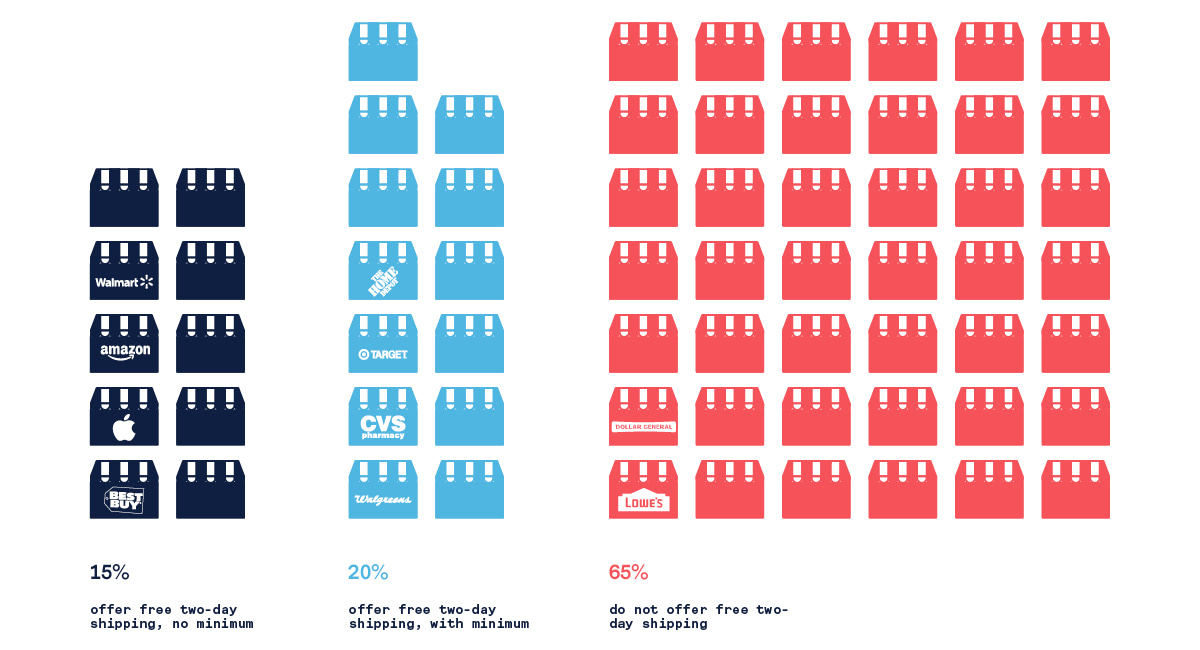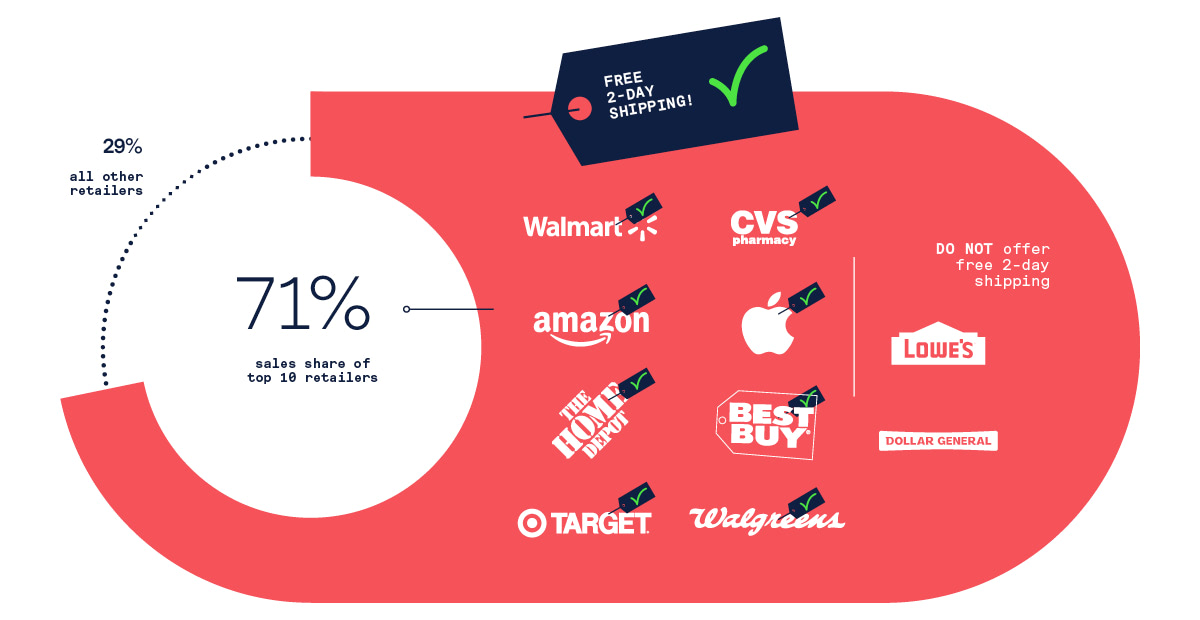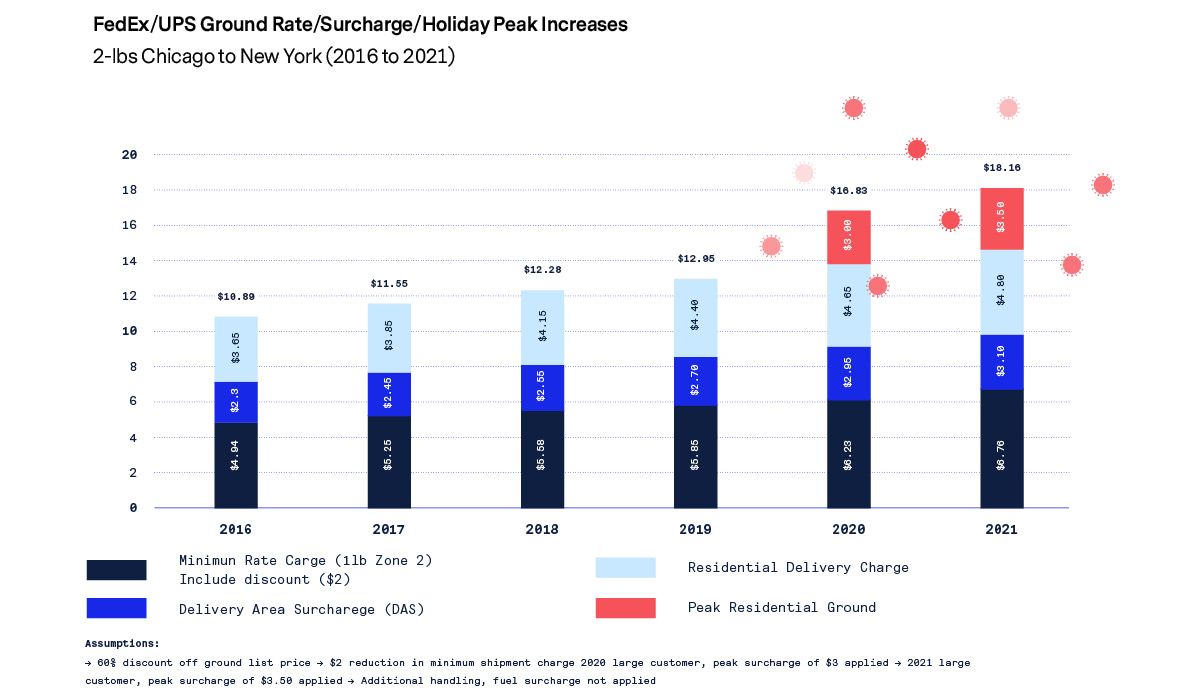You have likely heard the phrase, “There’s no such thing as a free lunch.” Even seemingly free fare comes with a price tag – even if you’re not the one paying. This includes shipping. Even when it’s free, it’s not free, which is bad news for brands who can’t afford to foot the bill. We surveyed 500 consumers and 200 brands and what we learned paints a startling picture of customer expectations.
In the days of yore, 2005, Amazon Prime’s promise of free two-day shipping was a novelty for online shoppers. Now, it’s the expectation. Amazon habituated customers to fast, free shipping, and now major retail players are following suit.
However, providing Amazonian agility is a tall order for brands, and one that comes with a substantial price tag.
The top 10 effect: 80% of the biggest retailers offer free two-day shipping
At first glance, fast, free shipping does not appear to be the norm. Amongst the top 100 US retailers we analyzed (excluding grocery and gas), 29% of retailers offer free two-day shipping, and most require a minimum purchase to qualify, which typically hovers around $50. Only 11% of retailers offer two-day shipping for free with no minimum purchase. These numbers alone make free shipping look like a nice perk to offer customers, but not something you need to remain competitive.
However, a closer look at the top 10 retailers paints a very different picture. The top 10 retailers represent 71% of all retail purchases. Whatever these companies do becomes standard. Forget the so-called Amazon Effect…it’s now the Top 10 Effect.
And when it comes to the top 10, eight of them provide free two-day shipping, and 6 require no minimum purchase. Only Amazon and CVS require a paid subscription to qualify. While Walmart does have a paid subscription service, Walmart+, they still provide free shipping on most items with no minimum purchase or membership required.
We are already seeing the impact on consumer expectations. Among the 500 consumers we surveyed, the vast majority cited free shipping and fast delivery as a non-negotiable expectation. Almost 1 in 4 listed free shipping as a “must-have,” meaning they’d take their business elsewhere if retailers don’t waive shipping costs. 76% of customers expect free two-day shipping for purchases of $40 or more, and 16% expect it for purchases of $60 or more.
Expectations are only going to get higher. There is already a sizable appetite for next-day delivery. 61% of consumers expect free next-day shipping, with 52% expecting it for a minimum purchase of only $40. This means the vast majority of customers now expect fast shipping without having to hit a minimum purchase.
The top 10 retailers are quickly seeing the writing on the wall and rising to meet this expectation. 40% of top 10 retailers already offer free next-day delivery. Among them, two require no minimum purchase. By comparison, less than 5% of retailers outside of the top 10 offer free next-day delivery.
This creates a significant power imbalance between the top 10 retailers and the rest of the market. Businesses that do not have the infrastructure and financial resources at their disposal to offer fast, free shipping are at a significant competitive disadvantage.
Why is this a problem?
It’s no secret that Amazon offers free shipping at a financial loss, as do many other major retailers.
Companies like Amazon, Target, and Walmart have the infrastructure and resources in place to provide fast, free shipping while other brands do not. These major players can easily lose money on shipping, as their bread and butter is customer loyalty. Incentivizing individuals to stay within their bubble for everything from laundry detergent to pet supplies to tennis shoes generates a lot of revenue. If free shipping creates lifelong customers, taking a financial hit on shipping costs is negligible in the grand scheme of things.
However, not every retailer can resign themselves to losing money on shipping – especially at the present moment.
Shipping costs are rising as fast as consumer demand for free shipping. Over the last five years alone, the cost of shipping a two-pound package via standard ground shipping rose by a whopping 71%. Global supply chain issues are also impacting shipping prices and hitting companies hard in the process. Since January of 2021, the cost of shipping by truck rose by 18.3%, while ocean freight costs rose 29%.
Within the traditional fulfillment paradigm, e-commerce orders are typically processed in large warehouse locations located hundreds of miles away from the final destination. Packages must be loaded into trucks, transported across multiple shipping zones, channeled to a sortation center, and then transferred to a van to finally reach a customer’s doorstep. Executing two-day deliveries is expensive enough. One-day delivery means factoring in the cost of an overnight flight, and same-day delivery? Forget about it.
This poses a huge strategic, operational, and financial challenge for brands. With a traditional centralized fulfillment strategy, even standard shipping costs have become prohibitive. That’s why the brands we surveyed cite reducing shipping costs as the a top factor for their success in the coming year. It is nearly impossible to stay afloat while providing fast, free shipping on par with the top 10 US retailers.
How to stay competitive: Get a little closer
While this paints what may look like a pretty bleak picture, fear not. There is hope for brands vying to compete with the big 10 retailers. It’s a matter of getting your goods closer to your customers.
Proximity is key to providing speedy delivery and lowering shipping costs, and yet most brands still rely on centralized fulfillment. There are quite a few problems with this model, all of which raise shipping costs and lengthen delivery times.
The good news? Centralized fulfillment is not your only option.
To provide fast delivery at a reasonable price, brands need to move fulfillment operations closer to customers. Distributed, local fulfillment operations have traditionally been inefficient, especially those that rely on manual labor. However, leveraging automation with high throughput in small spaces creates a more sustainable – and affordable! – model.
There’s no getting around it – brands must move fulfillment operations closer to where customers live. By augmenting your existing operations with the right distributed fulfillment strategy, you can do so while maintaining profitability. The end result is dramatically reduced shipping distances and costs, empowering you to provide services on par with big 10 retailers.




